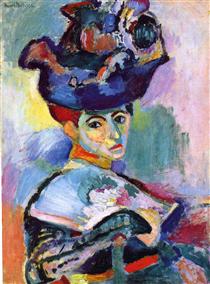What Is Henri Matisse Best Known For?
The paintings by Henri Matisse are widely recognized for their use of color and expressive, flowing brushstrokes. He is revered as one of the most significant painters of the 20th century, and his work had a substantial role in the development of both Fauvism and Modernism.
In addition, Matisse (1869–1954) is highly feted for his exploits in print, drawings, and other artwork. Yes, Henri Matisse ranks among the world’s renowned artists.
Contents
About Henry Matisse
Le Cateau-Cambrésis, France, is the birthplace of Henri Matisse. Early on, he began his creative education, first learning from a local painter before traveling to Paris in 1887 to enroll in the famed École des Beaux-Arts. Matisse’s artistic nature was influenced by the French Impressionists and the painters from his native North Africa while he was a student at the École.
All about Matisse’s artistic style
His use of intense, vivid colors and straightforward yet expressive brushstrokes define his aesthetic. In addition, Matisse was an expert at manipulating color to evoke a sense of mood and environment in his paintings.
Pablo Picasso, another outstanding artist of the time, and Matisse’s work are frequently contrasted. Although Picasso’s style frequently changed during his career, Matisse’s mainly stayed constant.
He established a distinctive and recognizable look because of this consistency. Check out Henri Matisse’s drawings to understand the kind of artist he was.
While most of Matisse’s early work was created in the then-dominant conventional French painting style, he started to create pieces uniquely his own while attending the École des Beaux-Arts. Fauvism is the name given to this distinctive aesthetic movement, and Matisse is one of its most well-known practitioners.
Famous paintings by Henri Matisse
Below are some famous Matisse paintings that continue to fascinate art enthusiasts who come across them. These Henri Matisse drawings express his mastery at producing lovely, expressive paintings.
The Red Studio (L’Atelier Rouge)
Henri Matisse’s Red Studio is a stunning and intriguing picture. It depicts Henri Matisse’s studio, filled with ceramics, paintings, and sculptures. In it, the artist has made the floor and walls into a single, uninterrupted expanse of crimson. The painting is a terrific discussion starter because of its striking colors and arrangement.
Matisse’s signature patterns and curves permeate the work, which is animated and energetic. The color red stands for the artist’s enthusiasm and inventiveness. This work of art is a stunning illustration of Matisse’s distinctive style and is likely to wow viewers. The Red Studio is a must-see for every art enthusiast since it is breathtaking.
Dance (LA DANSE)
This artwork, alongside its counterpart, the “Music painting,” was made for Russian art collector Sergei Shchukin. In it, a simple green countryside and a dark blue sky are contrasted with five dancing figures painted in a bold shade of red.
This Henri Matisse picture from 1910 illustrates how a moment may be perfectly captured in art. Even though the dancers in the artwork are imprisoned in time, they nonetheless exude motion and excitement.
The vivid colors and flowing lines give the picture a sense of vigor and life. La Danse, regarded as one of the most famous Matisse paintings, was a turning point in the evolution of modern art.
The Joy of Life (LE BONHEUR DE VIVRE)
Henri Matisse’s artwork, The Joy of Life, is a stunning and vibrant representation of life. The Joy of Life was considered Matisse’s breakthrough piece and the most avant-garde painting of its time. It shows several naked men and women in a vividly colored environment.
In the distance, a gathering of dancing people can be seen. By employing strategies like perspective shifts, which make the picture appear out of scale, Matisse defied traditional rules of western painting in this piece.
When the piece was initially presented, there was a great deal of public outcry. However, this lovely painting is today regarded as one of the cornerstones of early modernism and the finest work of Fauvism.
Blue Nude (NU BLEU, Souvenir of Biskra)
Henri Matisse’s painting Blue Nude is a remarkable and exceptional piece of art. The woman in the artwork is naked and reclining with her arms behind her head. The woman’s hair and torso are both shades of blue. The white backdrop of the artwork contrasts sharply with the blue hue of the woman’s body.
The usage of color, as well as the arrangement, make the picture distinctive. For example, the woman’s body is a startling shade of blue, making the painting more pure and vibrant.
Woman with a Hat (FEMME AU CHAPEAU)
Henri Matisse’s work, The Woman with a Hat, is distinguished by its vivid use of color and its distinctly formed characters. A woman is shown in the picture sitting on a chair and donning a hat and vibrant clothing. The backdrop has a geometric design and is also vividly colored.
Henri Matisse was among a group of artists that showcased their work at Paris’ Salon d’Automne in 1905. Ridiculers reviled these artists as “marauding wild animals;” later, this became the prominent art movement’s moniker. Ironically, Amélie Noellie Parayre’s sculpture (Matisse’s spouse) considerably fueled the critics’ snide attacks.
The public and reviewers were surprised by its unusually soft brushwork, unpolished appearance, and intense, non-naturalistic hues. However, with all that criticism, it became one of Matisse’s most well-known works and a superb illustration of the Fauvist movement.
Woman with a Hat – Henri Matisse
Conclusion
Henry Matisse’s work is highly recognized today. Some of the most prominent institutions house his works, like the Tate Modern in London and the Museum of Modern Art in New York. In addition, he is recognized as one of the most groundbreaking visual painters of the 20th century and one of the foremost figures in the Fauvist movement.
He is one of the most influential personalities in the history of art. His work significantly impacted contemporary art, inspiring artists across all genres for many years after his passing.


